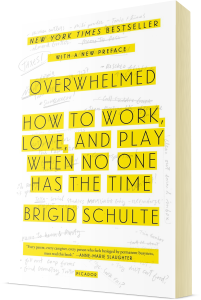Overwhelmed, Part II: The ideal worker is exhausting us
By Lea Z. Singh |
 |
| Visit the book's website. |
In this post, I discuss Part Two: Work, where Schulte looks in detail at how the American workplace contributes to people feeling overwhelmed, and how things could change.
The Ideal Worker
Schulte starts the section by explaining that most workplaces have not changed since the 1950s. They are designed for the traditional, linear career trajectory of men: they expect people to enter the workforce and work "full force for forty years straight".
Looking deeper still, our workplaces are built around a subconscious cultural stereotype which Schulte calls the "ideal worker". What does this ideal worker look like? "He is a face-time warrior, the first one in in the morning and the last to leave at night. He is rarely sick. Never takes vacation, or brings work along if he does. The ideal worker can jump on a plane whenever the boss asks...he is the one who answers e-mails at 3 a.m., willingly relocates whenever and wherever...and pulls all-nighters on last-minute projects at a moment's notice. In the blue-collar workplace, he is always ready to work overtime or a second shift." (77)
Schulte believes that "this notion of the ideal worker wields immense power in the American workplace. We are programmed to emulate him at all costs, or at least feel the sting of not measuring up." (77)
Personally, I call the ideal worker a "corporate monk". That's because his devotion to the workplace has a religious intensity about it, as if working were his religion and the workplace his monastery. In fact, Schulte writes that for many people today, the workplace has indeed replaced religion: "work now answers the religious questions of who we are and how we find meaning." (86)
Obviously, such an ideal is unhealthy. A workplace centred on the ideal worker is rigid, demands long hours and face-time in the office. It penalizes anyone who seeks flexible work arrangements. As Schulte says: "If we have designed workplaces around an expectation of work without end, if those workplaces expect all-out dedication of body, mind, and soul, then no one, male or female, has much of a choice. There is only one way to work to succeed or to survive: all the time." (76)
The problem with feminism
 |
| A Better Balance is a feminist organization that fights for better family policies. |
Perhaps this partly explains why the U.S. is "one of only 4 of 167 countries in the world with no [federally mandated] paid leave for parents" (98), and why only three U.S. states (California, New Jersey and Rhode Island) offer paid parental leave. (117)
 |
| Another feminist organization fighting for better working conditions for parents, nut just for women. |
As feminists pick up the fight for parental and family rights, a brand new kind of law has arisen. In recent years, "family responsibilities discrimination" has grown 500 percent from 2000 to 2010. Thousands of these lawsuits have been filed in "every state, in every industry, and at every level in organizations."
These lawsuits are being filed on behalf of mothers who were demoted, had pay reduced or were fired because of "perceived lack of commitment to the workplace", fathers who were "passed over for promotions or stigmatized" because of active family roles. and other such cases (73)
A new blueprint
Toward the end of this part of the book, Schulte gives examples of organizations that are structured in innovative ways and reject the ideal worker model. One of these organizations is Menlo Innovations, a software technology firm in Ann Arbour, MI. Schulte visits their offices and spends time with the founders and workers at the headquarters, and she describes their setup and functioning in a lot of detail.
While I won't reproduce all that information here, it is true that Menlo is a great case study. It is truly a leader in terms of family-friendly workplaces, and I bet its employees love it. Schulte also presents a series of other interesting companies that put families and flexibility at the top of their priority list, all in different ways.
One intriguing example that Schulte discusses in detail is Clearspire, an innovative law firm based in Washington, D.C.. There, former BigLaw lawyers worked much more flexible hours, entirely from their own homes. Clearspire is inspiring and I really enjoyed reading about it, as it gave me hope for the future of law firms. Unfortunately, I just learned that Clearspire closed down last summer, probably shortly after Schulte toured their headquarters. On the bright side, apparently other so-called "NewLaw" firms have been emerging whose working models are similar to Clearspire.
Schulte concludes this part of the book with a "bright spot" focus on the Pentagon, which turns out to be a famously workaholic place with insane hours. She meets up with Michele Flournoy, who worked as the "brains" of the Pentagon from 2009-2012, and discusses the family-friendly Alternative Work Schedule that Flournoy managed to institute during her time there. The AWS "entirely changed work culture in one key corner of the Pentagon" and allowed employees, both men and women, to see more of their families and lead more balanced lives. Schulte asks: "if the Pentagon can do it, why can't you?"
Schulte's exploration of different possible ways to structure the workplace is highly encouraging. It shows that there are indeed other ways of making the workplace work, and that we don't all have to become enslaved to the suffocating archetype of the ideal worker. While our working world is still at a very nascent stage of this transformation, the shift towards a more psychologically sustainable workplace is clearly a change that needs to happen, and urgently. Happily, in various places the ball is already rolling in that direction.
Category: book reviews, Lea Singh, motherhood, parenting


